Hangeul, the Korean alphabet, refers to the series of letters that
form syllables with which the Korean language is written. The most unique aspect
of Hangeul is that it was intentionally created by the government as a written
means of expressing the Korean language. History states that King Sejong, who
was the 4th king of the Joseon Dynasty, sponsored and helped in the scientific
creation of the alphabet with the help of a team of scholars, making it the most
significant invention in Korean history.
Koreans take pride in their alphabet. They believe that Hangeul
best demonstrates the creativity of Koreans during the past 5000 years of Korean
civilization. Koreans mark the 9th of every October as a national celebration to
commemorate the creation of Hangeul. As the only national celebration for an
alphabet in the world, this day reflects the uniqueness of an alphabet created
and systematized by a government to reflect the unique sounds of a language.
King Sejong, the creator of Hangeul, is regarded as a national
hero in Korea. There are in fact only two kings commemorated as truly great
kings of Korean history. One is Gwanggaetodaewang of Goguryeo, who ruled over
the largest territory in Korean history, and the other is King Sejong, who
created hangeul and many other significant inventions. King Sejong appears on
the 10,000 won note and a statue of him stands at Gwanghwamun Square, which is a
symbol of Seoul.
Hangeul is a series of creative and scientifically created
characters. The alphabet was originally composed of 17 consonants and 11 vowels
when it was first conceived however, now only 14 consonants and 10 vowels are
used. The 5 main consonants (ㄱ, ㄴ, ㅅ, ㅁ, ㅇ) imitate the shape lips and tongue
make when making that particular sound and reflect the five core elements of
Oriental philosophy. The 3 main vowels (ㆍ, ㅡ, ㅣ) symbolize the sky, the earth
and mankind, which are thought to be the origins of the universe. This
achievement came through the brainstorming of the best scholars of the time.
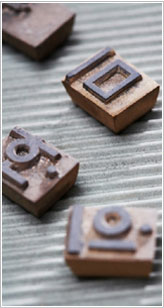 |
Consonants and vowels are used to write words by crossing and addition.
12,768 phonemes can be made in this way however, it is easy for everyone to
learn Hangeul because the composition principle of the words is so simple. Based
on the desire to create a writing system that could be easily learned and
accessed by all people throughout Korea, King Sejong worked to invent and
distribute this alphabet throughout the nation. Because of this, the illiteracy
rate in Korea is now virtually zero.
Hangeul was named Hunminjungeum at the time of its creation.
Hunminjungeum means “ Correct Sounds to Instruct the People ”. The Hunminjungeum
Explanation Book King Sejong created has been passed down throughout history;
the Korean government has named it National Treasure No. 70 and it is now housed
at the Gansong Art Museum in Sungbuk-dong, Seoul.
|
The quality of Hangeul has been extensively studied and praised by
experts worldwide. In 1989, UNESCO initiated the King Sejong Literacy Prize,
which is awarded to an individual or group, which contributes to the crusade
against illiteracy. This award has been bestowed since 1990. In addition, UNESCO
selected the Hunminjungeum Explanation Book as a Memory of the World in 1997.
Artwork utilizing the geometric features of the Korean
alphabet has recently become a hot item. One typical example is the work of the
fashion designer Sang Bong Lee. Lee received many compliments on the oriental
yet modern clothing she has created using the images of the Korean alphabet
while exhibiting at the pret a porter collection presentation in Paris.
Find out more on Hangeul
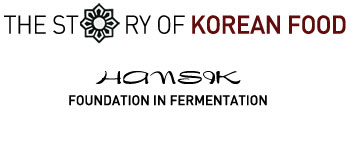 |
|
Korean food is referred to in Korean as Hansik. While many other
Asian ethnic foods such as Chinese or Japanese food have become popular
throughout the world, Korean food has yet to reach its peak. The Korean
government is crusading for the globalization of hansik in cooperation with
companies, civic groups and the mass media. As the people of the world gain a
better understanding of Korean food, its flavors, and its roots, Korean food
will undoubtedly become a global commodity like the food of Korea’s
neighbors.
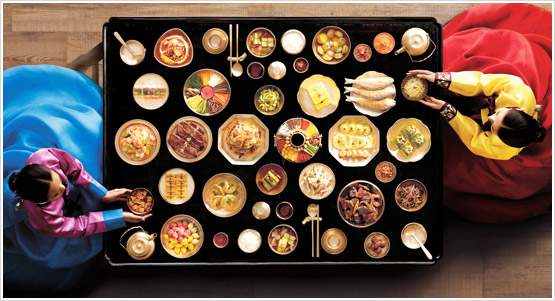
The key to Hansik is fermentation. Every nation has their unique
fermented foods such as cheese, yogurt or natto. There are many kinds of
fermented foods in Korean cuisine. The purpose of fermentation is to purposely
break down foods into more digestible components through the natural use of the
bacteria that exists all around us. Unlike food simply going bad, fermentation
represents a useful and practical change. So the Korean says not sseokhinda (to
be spoiled) but “sakhinda” (to be fermented). The expression is based on the
concept of in-depth understanding on fermentation. The quintessential fermented
food of hansik is kimchi, and although there are hundreds of different kinds,
the most internationally well known is spicy fermented cabbage. When meeting
someone who has never encountered kimchi before, Koreans may introduce its as a
type of salad, a kind of salad made using spices, red peppers, salt, garlic and
oriental cabbage, sauerkraut with a kick, if you will. But this simple
explanation leaves out the most important variable, that of fermentation, which
is the entire key to how a particular batch of kimchi might taste. The kimchi
that is preferred most by Korean people contains salted shrimp or anchovies and
has aged underground for at least a year in a jangdokdae (large clay jar). Like
a fine wine, the process of aging gives kimchi its deep taste.
Koreans express a well-aged kimchi as being "ripe". The verb of
"ripe' is often used for fruits. However, the Korean use it also for many kinds
of fermented food. As with fruit, edible after the process of blooming, growing
and ripening on the tree, in the same way, kimchi is allowed to develop its own
complexities of taste over a long period of time. The very idea of kimchi
embodies the notion of extended waiting.
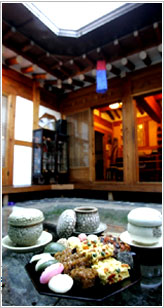 |
Some of the other typical fermented food found Korean table are jang (sauces)
of all kinds including ganjang (soybean sauce), gochujang (red pepper paste) and
doenjang (soybean paste) are known collectively as jang (sauces). The old saying
that the taste of food is the taste of sauce is highly applicable in hansik
because these sauces are the basis of Korean food. Sauces are added to most
Korean dishes and foods are classified depending on the kinds and quantity of
the sauces they contain
Koreans make their supply of kimchi once a year before winter to ensure they
get the nutrients they need during the winter. This tradition is known as
gimjang. The ‘jang’ in gimjang and ‘jang’ in ganjang, gochujang and doenjang are
the same word and reflects the same basic principle of
fermentation. |
Another feature of hansik is that it is strongly based on
vegetables. The basic composition of a table serving is steamed rice, soup and a
variety of side dishes. All of them are traditionally vegetable based; in fact,
a side dish of meat was typically a rare sight on the dining table of common
people. The cow in Korea, which has long been an agricultural society, was
regarded as a tool of labor rather than mere food.
Hansik is fundamentally a slow food, a cuisine well suited to
health and well being, because it is mostly based on vegetables grown locally
and aged and fermented sauces. One of the best opportunities for visitors to
Korea is 'the temple stay'. The most popular type of temple stay is one that
includes the true temple dining experience, which prohibits the use of meat and
of artificial flavors.
As the unique taste and undeniable health benefits of hansik are becoming
more widely known, the day is surely not far off where everyone will be able to
enjoy hansik at home or at their neighborhood Korean restaurant.
|
| [Major Korean foods] |
|
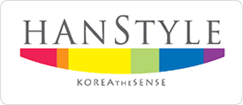 Asian countries have been doing exchanges through
culture and trade throughout history. Trends spread throughout the region at an
incredibly fast rate. The 80's were a time for “Hong Kong Noir” while the 90's
were more an age of Japanese animation. The 2000s have seen a sharp rise in the
popularity of Korean culture, with music and dramas hitting all the right notes.
Interest in Korea, triggered by the success of leading Korean dramas and popular
music, continues to escalated to include a host of other aspects of Korean
culture, such as hangeul (Korean alphabet), hansik (Korean food), hanbok
(traditional Korean clothing), hanok (traditional Korean houses), hanji
(traditional Korean paper), as well as Korean music. In Korea, the
aforementioned six cultural symbols are collectively referred to as “Han Style”.
Asian countries have been doing exchanges through
culture and trade throughout history. Trends spread throughout the region at an
incredibly fast rate. The 80's were a time for “Hong Kong Noir” while the 90's
were more an age of Japanese animation. The 2000s have seen a sharp rise in the
popularity of Korean culture, with music and dramas hitting all the right notes.
Interest in Korea, triggered by the success of leading Korean dramas and popular
music, continues to escalated to include a host of other aspects of Korean
culture, such as hangeul (Korean alphabet), hansik (Korean food), hanbok
(traditional Korean clothing), hanok (traditional Korean houses), hanji
(traditional Korean paper), as well as Korean music. In Korea, the
aforementioned six cultural symbols are collectively referred to as “Han Style”.
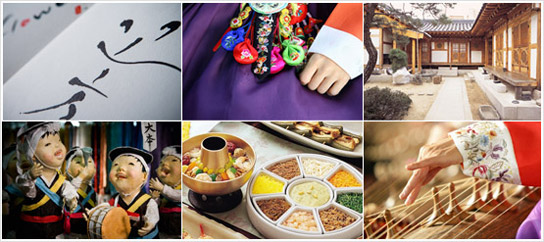
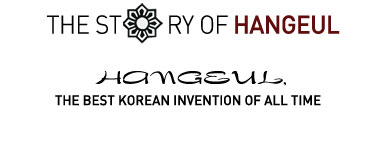
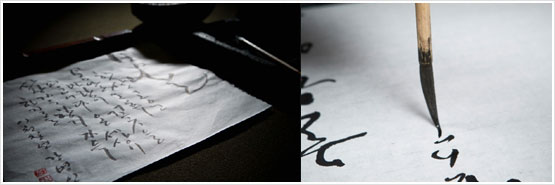




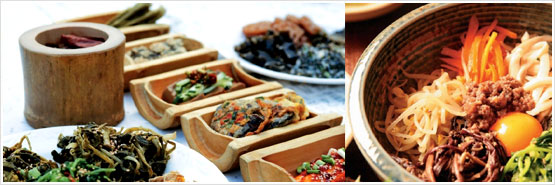
댓글 없음:
댓글 쓰기